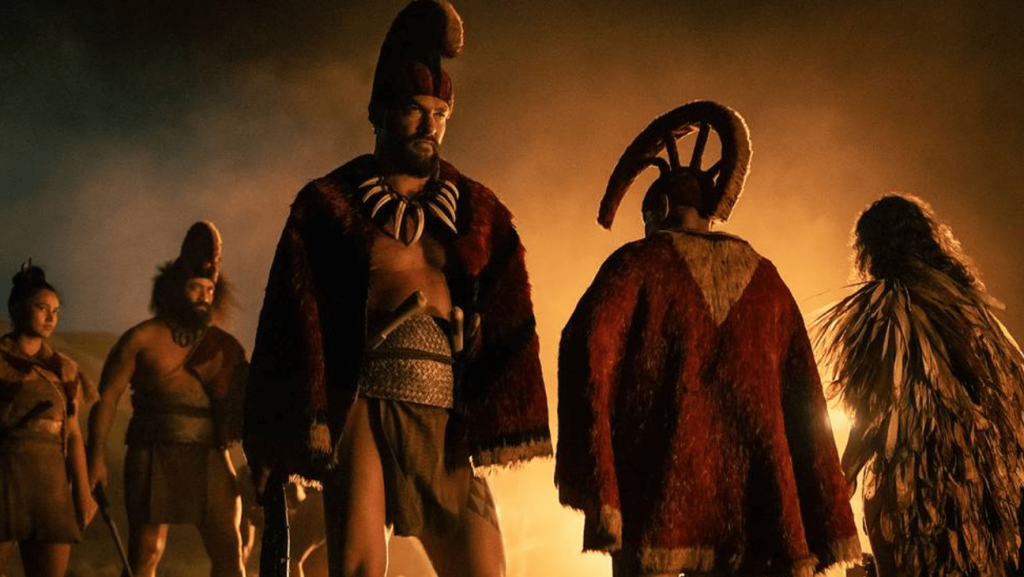FX’s adaptation of James Clavell’s Shōgun was one of 2024’s buzziest shows, breaking Emmy Awards records and performing well enough that what had started as a limited series sparked development on second and third seasons.
Still, there were viewers who lamented that Shōgun spent too much time on its extended game of political chess, neglecting the epic samurai battles that they felt they’d been promised.
Chief of War
The Bottom Line
Strong big moments, dull character beats.
Airdate: Friday, Aug. 1 (Apple TV+)
Cast: Jason Momoa, Luciane Buchanan, Temuera Morrison, Te Ao o Hinepehinga, Cliff Curtis, Kaina Makua, Moses Goods, Siua Ikale’o, Brandon Finn, James Udom, Mainei Kinimaka, Te Kohe Tuhaka and Benjamin Hoetjes
Creators: Thomas Paʻa Sibbett and Jason Momoa
That bloodthirsty audience is more likely to feel well-served by the first season of Apple TV+‘s Chief of War, from creators Thomas Pa’a Sibbett and Jason Momoa.
Over nine hourlong episodes, the show delivers a handful of grand set pieces within a context that feels suitably and satisfyingly epic. During those highlights, the drama is brutal, bracing and frequently gorgeous. It would be the rare television series that I wouldn’t mind checking out on the big screen — except for how often the human elements in between those sequences feel like filler. They’re a selection of undeveloped or half-developed supporting characters failing to deliver sufficient historical nuance around Momoa’s central performance, which, though it may play only one or two notes, does so with ample charisma.
Momoa, who co-wrote every episode and directed the finale, plays Ka’iana, a warrior chief in self-imposed exile as the series begins. It’s a nebulous point in “the late 18th century” and Ka’iana has abruptly left his position as military advisor to Maui’s King Kahekili (Temuera Morrison), whose vicious adherence to a prophecy involving the ruler who will unite the Hawaiian kingdoms makes Ka’iana uncomfortable.
Ka’iana is living with his ohana — brothers Nahi (Siua Ikaleʻo) and Namake (Te Kohe Tuhaka), wife Kupuohi (Te Ao o Hinepehinga) and her sister Heke (Mainei Kinimaka) — doing peaceful things like fishing and riding around on the backs of sharks. King Kahekili somehow lures Ka’iana back into the fold for an attack on the kingdom of O’ahu, a massacre that leaves Ka’iana questioning Kahekili’s sanity and, through circuitous circumstances, lands him on a Western trading vessel that allows him to see much of the world and learn about pants.
At the same time, we meet Ka’ahumanu (Luciane Buchanan), who was born to royalty but raised in exile herself. Ka’ahumanu is promised in marriage to Kamehameha (Kaina Makua), a nephew of King Kalani’opu’u more interested in farming than war — at least until Kalani’opu’u dies and leaves the “God of War” title to Kamehameha instead of the ascending king, Cliff Curtis‘ Keoua.
Don’t worry if you can’t keep up with the different chiefs and kings and kingdoms, nor with why Keoua is so frustrated at being named king but not the “God of War.” All you need to know is that when we begin, Hawaii is divided and peaceful, but that things get bloodier and more deadly as the series progresses, because the distinctions mean a lot to the characters involved. Plus, white men are coming and not just to get leis at the airport.
There are battles scattered throughout Chief of War, and while viewers may not always fully understand the stakes of each individual skirmish, all that truly matters is that whatever side Jason Momoa is fighting on — sometimes in indelible capes and headdresses and other times in no-frills casual thongs, all kudos to costume designer Caroline Eselin-Schaefer — that’s who you’re supposed to be rooting for. Which is simple enough.
Although the story of Hawaiian unification has been frequently told with Kamehameha as its centerpiece, here the future king is reduced to a woefully naive idealist, eager to avoid conflict and happy to maintain a cautious peace with the “Paleskins.” Momoa’s Ka’iana, in contrast, gives the impression of having watched the first season of The White Lotus, so he knows that while welcoming outsiders might bring trade, it’s more likely to lead to cultural subservience and erasure. Whatever he says or aspires to is usually correct, even when it involves an unconditional embrace of the white man’s guns, a bellicose cheat code on par with dragons in Game of Thrones or, well, the white man’s guns in Shōgun.
Ka’iana’s most significant conflict is between backward-looking tradition and the possibility that, for the sake of the future, it might be necessary to sacrifice the old ways for a bigger bang. This, coincidentally, is also the biggest conflict external to Chief of War.
There’s a commitment to authenticity that you can sense throughout, though the execution can be uneven. Chunks of the series, including a jaw-dropping action scene in the finale, were shot in Hawaii, though most of it was shot in New Zealand. Much of the cast is Native Hawaiian and (thanks to the shooting location) many others Maori and Tongan, in an impressive display of indigenous and Pacific Islander representation.
The Olelo Hawai’i native language is used throughout much of the season, especially in the first two episodes — though in subsequent episodes, Ka’iana’s journeys to the West, as well as the presence of at least one British soldier left behind in Hawaii, give most of the characters an excuse to learn English and speak it at logically inconsistent times. While the linguistic choice is distinctive, I could never shake the feeling that while some of the actors speak it like a living tongue, others come across like they’re reading from cue cards, and the conversations frequently sound clumsy.
For all of the show’s interest in grounded realism, many of the most vivid moments are anchored or at least embellished by matte art and CG effects, including Ka’iana’s shark buddy, the volcanic eruptions that escalate as the narrative goes along and several of the most beautiful island vistas. The cinematographers, led in the opening episodes by Matthew Chuang, still capture plenty of natural grandeur, but you can absolutely tell the difference.
The battle sequences in Chief of War are robust, with Justin Chon setting the tone in the first two episodes and Momoa’s work in the last 15 minutes of the finale sealing the deal. They’re visceral and bloody confrontations meant to showcase the intimacy of hand-to-hand combat against the grotesque inhumanity introduced by Western innovations like rifles and cannons.
They’re also aesthetically inspired by a run of ’90s and ’00s films that blended blockbuster stunt work with historical themes that boiled down to, “Man, the past was gory.” It’s hard not to see direct nods to the likes of Braveheart, Saving Private Ryan, The Patriot, Apocalypto and Gladiator here, making the “history” that the series reflects more Hollywood than Hawaiian — a distinction which gets thoroughly blurred. Some of the biggest names in the industry have tried to mount Kamehameha biopics over the decades and you could argue that Chief of War, however representationally progressive, won’t get in the way of somebody aspiring to more accuracy.
Certainly Makua isn’t giving a definitive performance as Kamehameha, but like most of the supporting actors, his concentration is on delivering the Hawaiian dialogue convincingly and striking physical stances boldly. The most interesting character is Brandon Finn’s Prince Kupule, son of Kahekili, but I kept waiting in disappointment for a payoff to several key details. The most memorable supporting performances come in scenery-chewing form from Curtis and Morrison, the first foregrounding a jealousy that doesn’t entirely make sense and the other a megalomania that does make sense but is one-dimensional.
Speaking of one-dimensional, the series’ actresses all have fleeting moments that let them add characterization — Kinimaka is especially good in the finale — but simply saying, “This woman is a warrior” and “This woman has wisdom” isn’t honoring these characters. This is a writing flaw and it’s notable that all of the credited writers and directors are men, though that doesn’t need to be a dealbreaker. Michael Hirst wrote every episode of Vikings, a somewhat superior drama with a very similar assortment of cinematic inspirations, and his collection of leaders and shield maidens were far more vital.
I won’t get into how pointless the Western characters are. It’s not their story. It shouldn’t be their story. But other than James Udom’s Tony, they’re all a bunch of space-wasting guys named “John.”
Really, none of the supporting figures even matter, because Chief of War is Momoa’s show, and he commands every frame with his familiar high-intensity, feral sneer. The actor’s outsized swagger has been the basis of many of his best performances, whether you see more traces of his Baba Voss from Apple TV+’s See or Khal Drogo from Game of Thrones. Momoa isn’t our rangiest actor — personally, I like him best when he gets to be silly — but if you need a guy who, in a time of violent conflict, all eyes will turn to to strike the first blow, there are few better.
Fortunately, that’s mostly what Momoa the writer requires of Momoa the actor in Chief of War. Whether it’s clinging to a shark, sledding down a mountain or wiping out small armies with a toothy lei o mano, Momoa’s control over the biggest moments is so confident that many viewers will be more than happy to ignore the poorly developed ethical debates and flimsy romances that fill so much of the nine hours. It’s a series whose highlights render its lowlights all the more forgettable — often for worse, but fundamentally for better.

